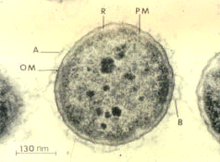Aeromonas salmonicida
| Aeromonas salmonicida | |
|---|---|
 |
|
| Scientific classification | |
| Domain: | Bacteria |
| Phylum: | Proteobacteria |
| Class: | Gammaproteobacteria |
| Order: | Aeromonadales |
| Family: | Aeromonadaceae |
| Genus: | Aeromonas |
| Species: | A. salmonicida |
| Subspecies: | A. salmonicida |
| Binomial name | |
|
Aeromonas salmonicida (Lehmann and Neumann 1896) Griffin et al. 1953 |
|
| Synonyms | |
|
Bacillus salmonicida (Lehmann and Neumann 1896) Kruse 1896 Bacterium salmonicida Lehmann and Neumann 1896 Proteus salmonicida (Lehmann and Neumann 1896) Pribram 1933 |
|
Bacillus salmonicida (Lehmann and Neumann 1896) Kruse 1896 Bacterium salmonicida Lehmann and Neumann 1896 Proteus salmonicida (Lehmann and Neumann 1896) Pribram 1933
Aeromonas salmonicida is a pathogenic bacterium that severely impacts salmonid populations and other species. It was first discovered in a Bavarian brown trout hatchery by Emmerich and Weibel in 1894.Aeromonas salmonicida's ability to infect a variety of hosts, multiply, and adapt, make it a prime virulent bacterium. A. salmonicida is an etiological agent for furunculosis, a disease that causes septicemia, haemorrhages, muscle lesions, inflammation of the lower intestine, spleen enlargement, and death in freshwater fish populations. It is found worldwide with the exception of South America. The major route of contamination is poor water quality; however, it can also be associated stress factors such as overcrowding, high temperatures, and trauma. Spawning and smolting fish are prime victims of furunculosis due to their immunocompromised state of being.
Aeromonas salmonicida is a Gram-negative, facultatively anaerobic, nonmotile bacterium. It is rod-shaped, about 1.3–2.0 by 0.8–1.3 μm in size, and grows optimally at temperatures between 22 and 25 °C. The bacterium readily ferments and oxidizes glucose, and is catalase- and cytochrome oxidase-positive. Its molecular properties include a special surface protein array called the A-layer, which is believed to be responsible for the bacterium's virulent traits, and lipopolysaccharide, the cells' major cell envelope antigen. The A-layer consists of a 50-kD protein, and provides protection to the bacterium. The lipopolysaccharide consists of three moieties: lipid A, a core oligosaccharide, and an O-polysaccharide (O-antigen). The extracellular products of A. salmonicida consist of 25 proteins, enzymes, and toxins, and many more. In addition, the genome is composed of a single circular chromosome (4,702,402 bp), with two large and three small plasmids. The chromosome yields 58.5% of G+C pairs, has 4086 encoding proteins, and totals 4388 genes.
A. salmonicida isolates flourish when grown on blood agar or tyrosine. Large colonies are observed along with a brown diffusible pigment within two to four days. Most typical strains are morphologically and biochemically homogenous with a few exceptions. Some of these exceptions include a distinguishable variation in pigment production, the bacterium's ability to ferment selected sugars, and Voges-Proskauer assay results.
A. salmonicida is a facultative anaerobe, which means it is capable of making ATP by aerobic respiration if oxygen is present, but is also capable of switching to fermentation when oxygen is not present. It does not ferment sucrose or lactose, using glucose in this pathway, instead; glucose fermentation creates gas. The bacterium grows optimally at temperatures between 22 and 25 °C. The maximum temperature at which it can grow is 34.5 °C. After about a 24-hour growth period, the bacterial colonies reach about the size of a pin point. The colonies also have a brown pigmented color that appears after it has been growing for 48–72 hours.
...
Wikipedia
